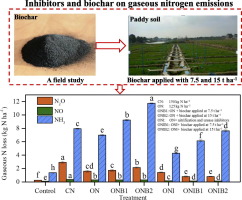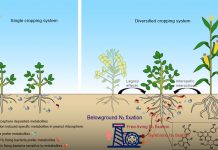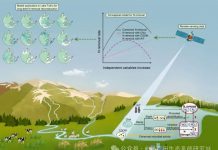Tiehu He,Deyan Liu,Junji Yuan,Jiafa Luo,Stuart Lindsey,Nanthi Boland,Weixin Ding. Effects of application of inhibitors and biochar to fertilizer on gaseous nitrogen emissions from an intensively managed wheat field. Science of The Total Environment,(628–629):121–130.
Abstract
The effects of biochar combined with the urease inhibitor, hydroquinone, and nitrification inhibitor, dicyandiamide, on gaseous nitrogen (N2O, NO and NH3) emissions and wheat yield were examined in a wheat crop cultivated in a rice-wheat rotation system in the Taihu Lake region of China. Eight treatments comprised N fertilizer at a conventional application rate of 150 kg N ha−1 (CN); N fertilizer at an optimal application rate of 125 kg N ha−1 (ON); ON + wheat-derived biochar at rates of 7.5 (ONB1) and 15 t ha−1 (ONB2); ON + nitrification and urease inhibitors (ONI); ONI + wheat-derived biochar at rates of 7.5 (ONIB1) and 15 t ha−1 (ONIB2); and, a control. The reduced N fertilizer application rate in the ON treatment decreased N2O, NO, and NH3 emissions by 45.7%, 17.1%, and 12.3%, respectively, compared with the CN treatment. Biochar application increased soil organic carbon, total N, and pH, and also increased NH3 and N2O emissions by 32.4–68.2% and 9.4–35.2%, respectively, compared with the ON treatment. In contrast, addition of urease and nitrification inhibitors decreased N2O, NO, and NH3 emissions by 11.3%, 37.9%, and 38.5%, respectively. The combined application of biochar and inhibitors more effectively reduced N2O and NO emissions by 49.1–49.7% and 51.7–55.2%, respectively, compared with ON and decreased NH3 emission by 33.4–35.2% compared with the ONB1 and ONB2 treatments. Compared with the ON treatment, biochar amendment, either alone or in combination with inhibitors, increased wheat yield and N use efficiency (NUE), while addition of inhibitors alone increased NUE but not wheat yield. We suggest that an optimal N fertilizer rate and combined application of inhibitors + biochar at a low application rate, instead of biochar application alone, could increase soil fertility and wheat yields, and mitigate gaseous N emissions.








